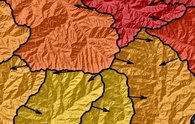Rates of drainage divide migration
Bedrock river incision drives the topographic evolution of mountain ranges, orchestrating the adjustment of rivers and valleys towards a configuration with erosion rates everywhere equal to rock uplift rates. Analyses relating topography to climate and tectonics often assume landscapes approach this steady-state condition and thereby associate knickpoints, low relief plateau surfaces, and other transient topographic features with changes in external forcing. Because bedrock river incision rates depend on river discharge, migration of drainage divides and consequent changes in drainage area can also modify erosion rates and generate transient topography. The extent to which divide migration influences landscape evolution is uncertain because the rates and timescales over which drainage divides migrate are not well known. Small-scale laboratory experiments of uplifting landscapes exhibit persistent divide migration, whereas numerical landscape evolution models tend to develop static drainage networks under constant forcing. Sediment provenance studies and irregular channel network geometries indicate that drainage divides do migrate in nature, but only recently have efforts been made to systematically identify when and where divide migration occurs.
We are developing analytic expressions for the velocity of drainage divides, based on equations commonly used to describe fluvial and hillslope erosion, and applying them to digital elevation datasets and topography generated by landscape evolution models. To validate our methods, we are comparing predicted divide velocities to modeled velocities, cross-divide differential erosion rates, and other recently proposed topographic indicators of divide mobility.
Project investigators: Kim Huppert and Jean Braun

